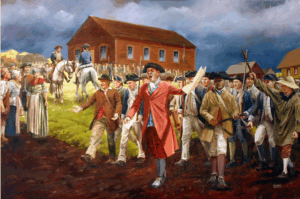 A monetary debt crisis in 1786 fomented insurrection. I learned about Shays’ Rebellion in Western, Massachusetts, while writing the first book of a trilogy based on my ancestors. Job Hodges, Jr., my fifth great-grandfather, lived in Taunton, Massachusetts, and was a minuteman during the Revolutionary War.
A monetary debt crisis in 1786 fomented insurrection. I learned about Shays’ Rebellion in Western, Massachusetts, while writing the first book of a trilogy based on my ancestors. Job Hodges, Jr., my fifth great-grandfather, lived in Taunton, Massachusetts, and was a minuteman during the Revolutionary War.
In the novel, he reluctantly participates in suppressing the insurrection. I do not know whether he did or not, but it makes for a great story. And that’s the beauty of fiction!
CAUSES OF THE MONETARY DEBT CRISIS
After the Revolutionary War, Americans did not live happily ever after because:
- The debt from the war was staggering.
- Specie (money in the form of coins) was in short supply, and inflation, caused by printing too much paper money, soared. Those living in Massachusetts bartered for what they needed.
- England curtailed trade with the Americans.
- With the economy sagging, people struggled to pay their debts, and the availability of loans dried up.
- Hefty government taxes had to be paid in cash.
- The state owed veterans back pay and allowances.
- Everyone was in debt, so they sued each other.
MONETARY DEBT CRISIS AND ITS IMPACT ON THE LITTLE MAN
When the farmer could not pay judgments against him, his property and belongings were seized—everything could be taken, including the clothes on his back. Then, if the debt was not satisfied, the debtor was thrown into prison.
Frustrated farmers, mechanics, and laborers, many of whom were veterans, banded together to see that the courts were closed, blocking judgments against them. Fifteen hundred strong, they were known as the Regulators.
This group, led by war veteran Daniel Shays, was, in general, not violent and respected others’ property.
THE GOVERNMENT CLAMPS DOWN DURING THE MONETARY DEBT CRISIS
By November 1786, the Massachusetts legislature offered an amnesty to those who interfered with the courts. However, they also passed the Militia Act, which stated that anyone who took up arms against the state would be executed. Furthermore, the writ of habeas corpus was suspended until July 1787.
THE MONETARY DEBT CRISIS REBELLION IS SQUASHED
Because Congress had no power to raise an army, Massachusetts called on General Benjamin Lincoln to organize a militia. Merchants from Boston footed the bill.
In January 1787, the Regulators marched to the Springfield Armory, hoping to procure weapons to continue their fight. However, the state militia was waiting. Cannon fire killed four Regulators and wounded twenty. The rebels melted into the countryside, ending the rebellion.
Two insurrectionists were hanged, while the vast majority, including Shays, were pardoned. The government reduced taxes and extended the payment period for farmers and soldiers.
UNEXPECTED CONSEQUENCES OF THE MONETARY DEBT CRISIS
The rebellion shook the country’s leaders, who realized that a stronger government than the one created by the Articles of Confederation was needed. The result was the Philadelphia Convention of 1787, which created the United States Constitution.
LAST THOUGHTS ON THE MONETARY DEBT CRISIS
The Big, Beautiful Bill is pending in Congress. Parts of that bill deliver tax cuts to the wealthy and powerful while squeezing the little man by decreasing access to medical care and other safety net measures. Such a move allows titans of industry such as Jeff Bezos to have larger and more lavish weddings.
The Congressional Budget Office determined that this bill would add $2.4 trillion to the deficit, not including interest payments.
And, how will all of this money be paid off? Apparently not by the wealthy. My guess is that it will fall on the back of the little man in ways we cannot imagine. And that will be bad for America.
Sign up on www.mariewatts.com to receive future Stories About Life delivered to your email address or read more stories by clicking here.

Recent Comments